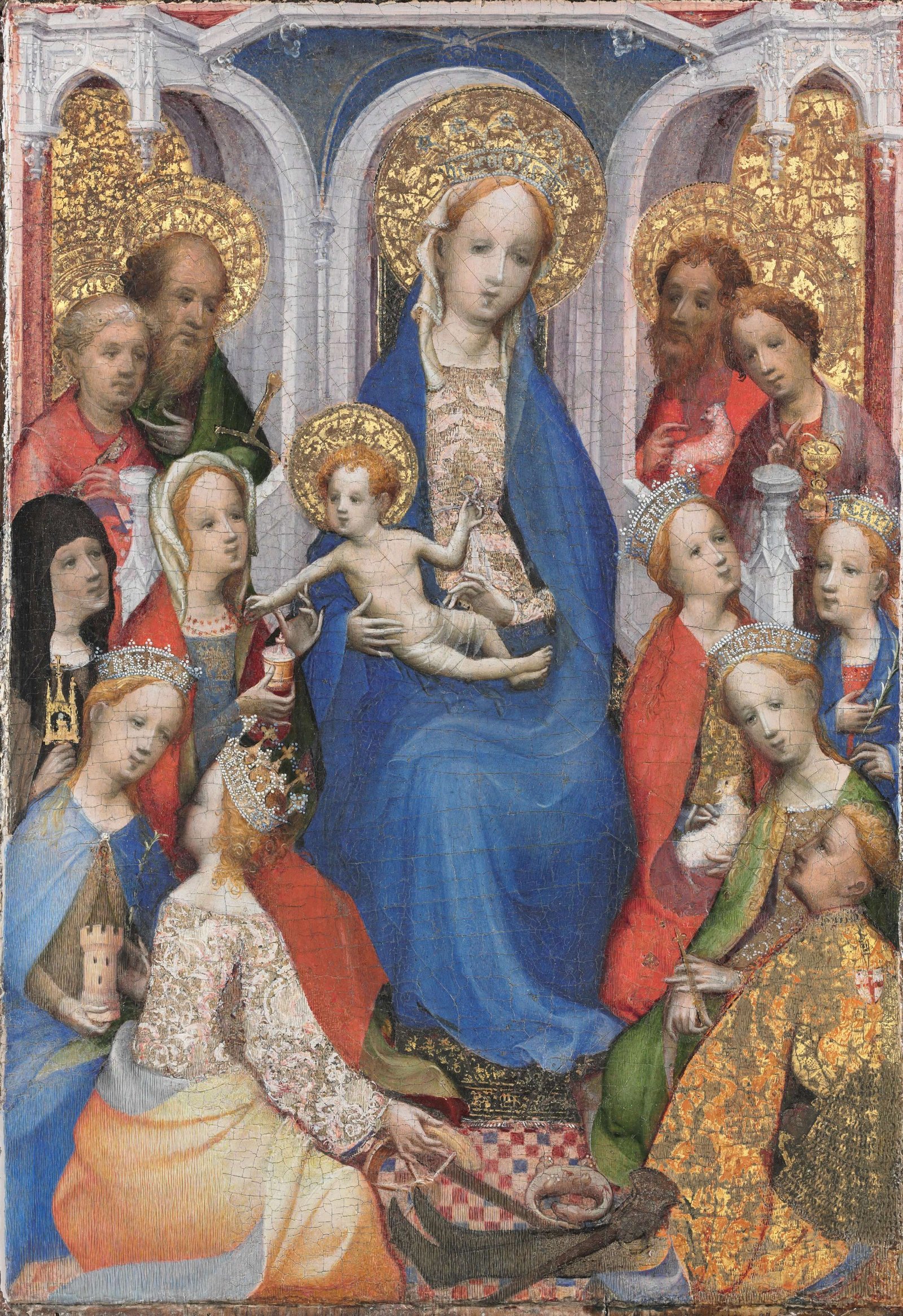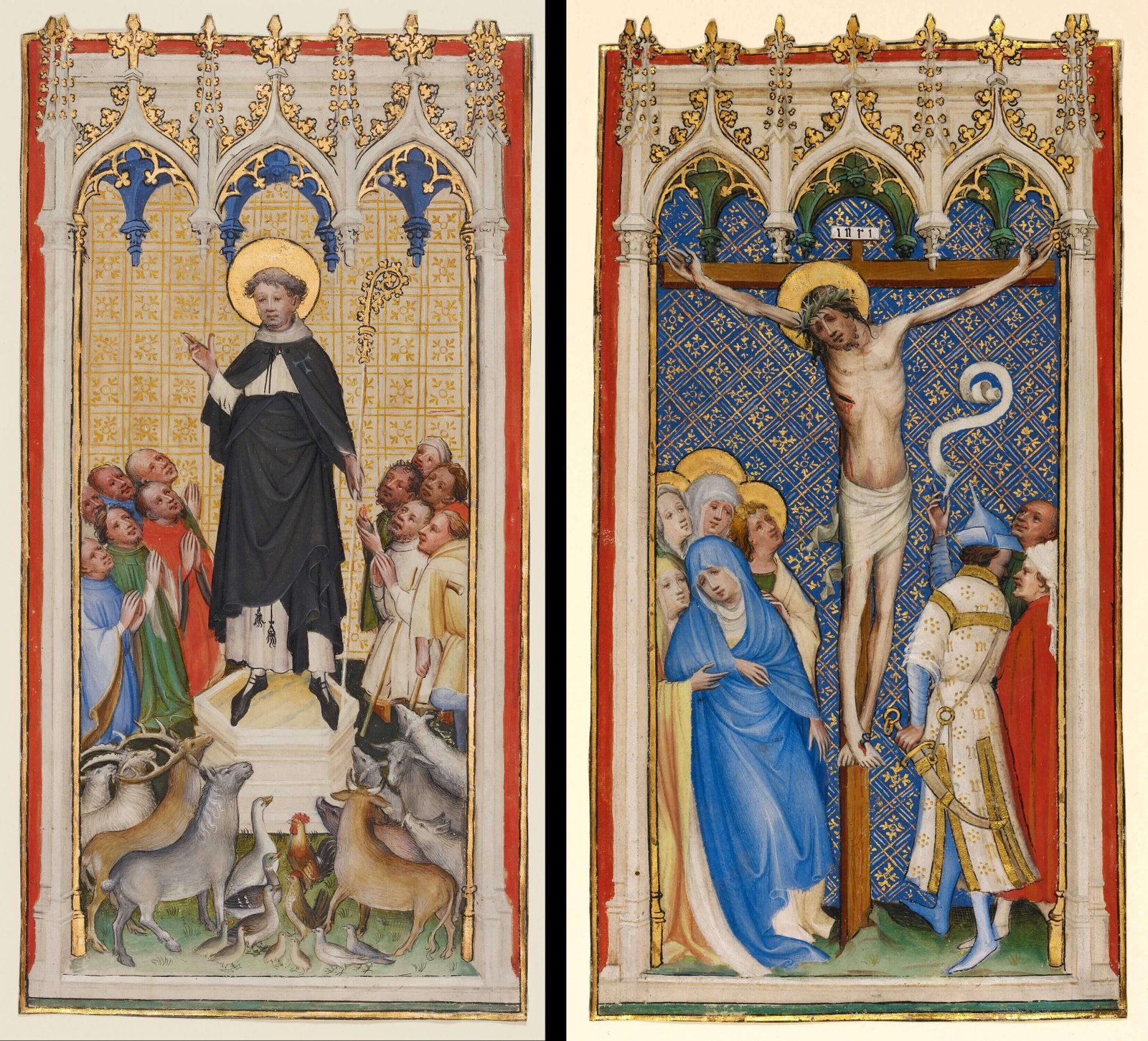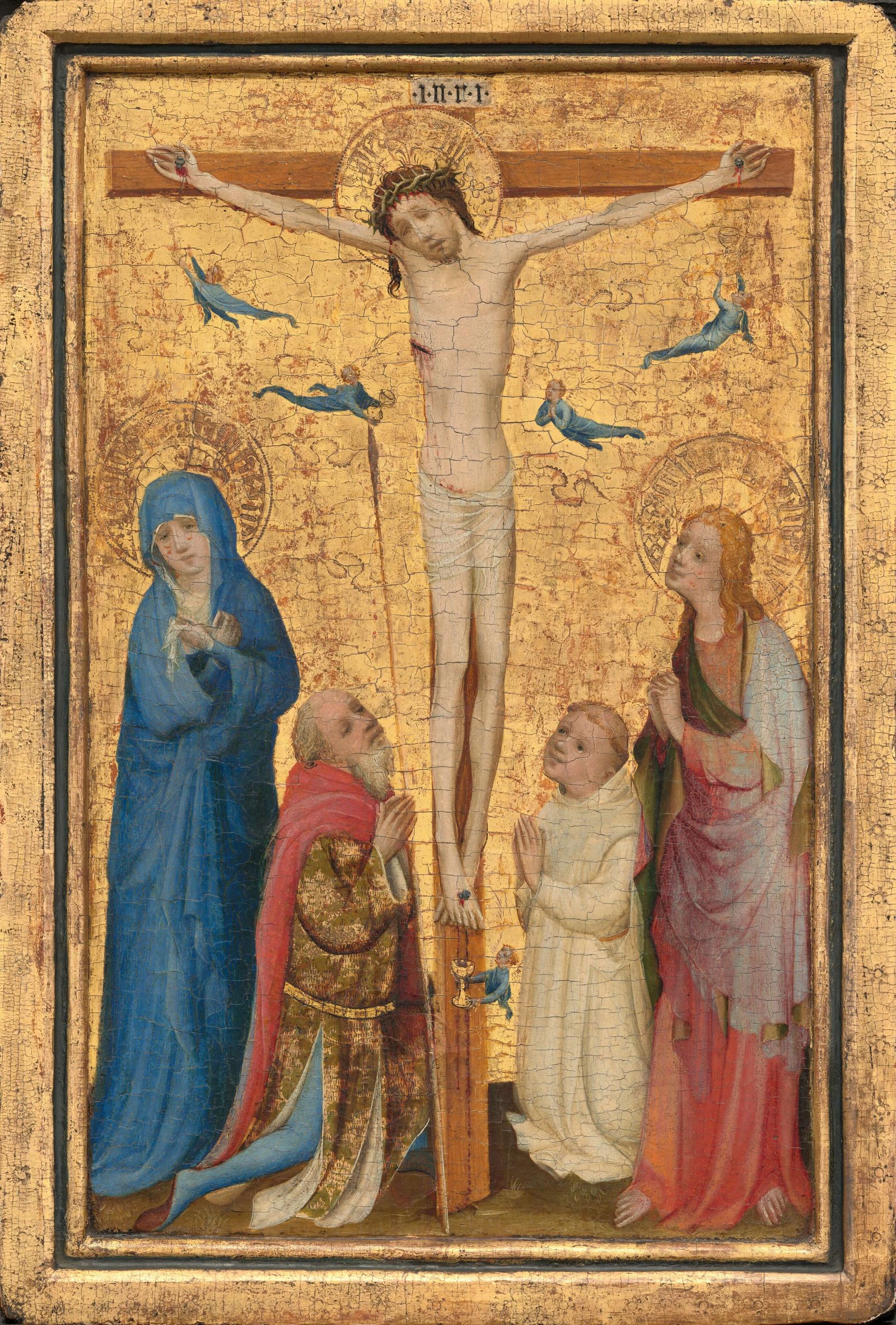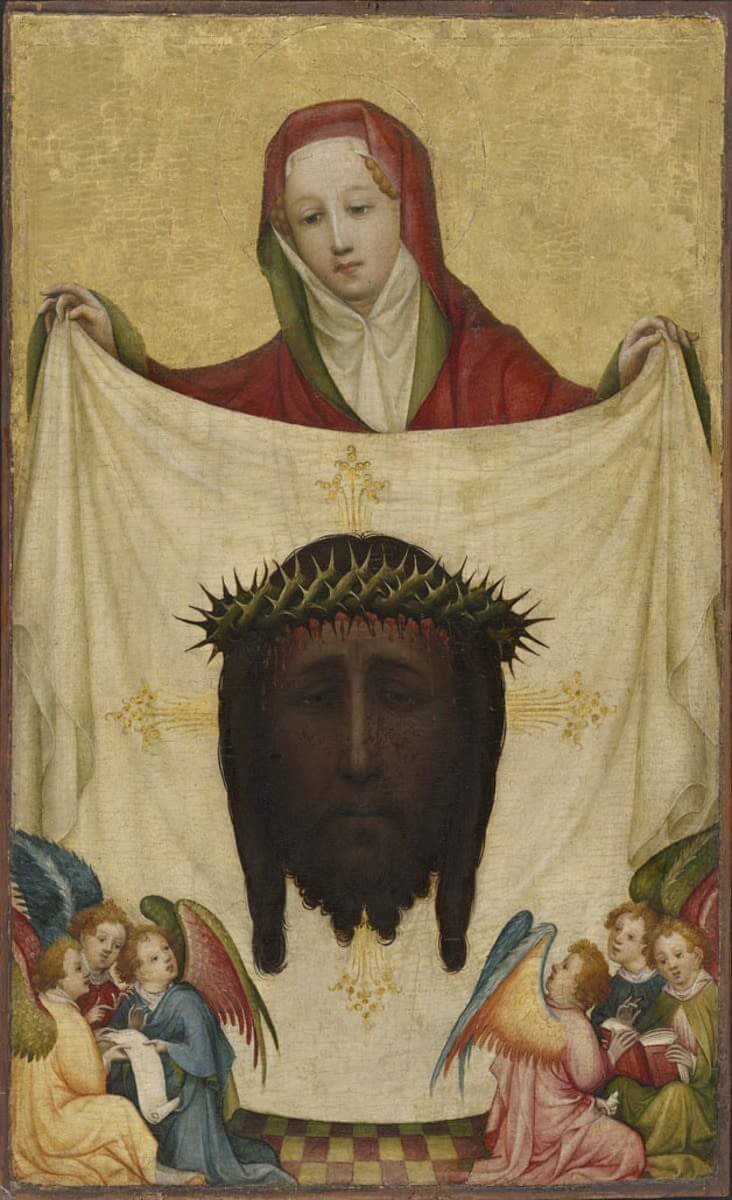My Facebook and Instagram Advent Calendar for December 7th, 2022 features the early-15th century painting Enthroned Virgin and Child with Saints, which is attributed to the Master of Saint Veronica. If you saw it, you may be wondering who the Master of Saint Veronica was and what it means for this painting to be attributed to him. All your answers are here. This article will introduce you to attribution – the process by which art historians make educated suppositions about who made an artwork – and the pseudonyms given to artists whose real names we don’t know.

When the Artist is Unknown
It might surprise you to learn that we aren’t definitively sure who made a great many historical artworks. Because it hasn’t always been customary for artists to sign their works, it is easy for the physical objects to get separated from their biographies over time. (Signatures aren’t necessarily infallible, anyway. They can easily be added later by unscrupulous collectors or dealers looking to boost the value of their collections.) Additionally, historical documentation tends to be patchy in its content, survival, and reliability, making it quite difficult to firmly link an artwork in front of us today with a document written centuries ago.
Taking the example of the painting above, the enthroned Virgin and Child was one of the most popular subjects for art in the Middle Ages and Renaissance. If we find a letter or inventory mentioning that this subject was painted by a particular artist, how are we supposed to know that it refers to this painting and not one of the hundreds of others out there? A thorough description of the colors, composition, selection of saints (if we can agree on their identities), etc. would help, but documents rarely give us all this information. After all, since enabling later identifications wasn’t their intended purpose. While they are definitely helpful tools of art historical and provenance research, such primary sources aren’t usually enough to make attributions from on their own.

Making Attributions
In the absence of hard evidence, art historians often rely on connoisseurship to attribute artworks to known (or sometimes unknown) artists. This is what allows the majority of paintings and sculptures in the average museum to have names associated with them despite the challenges I just mentioned. Connoisseurship is the process of closely analyzing an artwork’s style and drawing on a keen understanding of relevant artists’ styles to make an educated supposition about the identity of the artist who created it. Such attributions cannot be definitively proved, but they can be accepted or rejected by the scholarly community at large. They can also be reconsidered later, and some artworks have had several different attributions throughout their lifetimes (like the Allentown Art Museum’s Rembrandt). Connoisseurship is a fascinating and often controversial aspect of art history that really needs a post of its own in the near future.
When general consensus within art history supports an attribution, the artist can be listed on labels and captions without any qualifiers. Therefore, you can’t tell just from looking at the label if the attribution was the result of a connoisseur’s judgement or outside evidence. (It’s also why most museum-goers don’t realize this phenomenon exists.) In cases where some scholars support the attribution but others disagree, the qualifier “attributed to” typically goes before the artist’s name to indicate that there is some doubt, as in our Enthroned Virgin and Child with Saints attributed to the Master of Saint Veronica. Consider this an asterisk next to the attribution.
“Attributed to” is not the only possible qualifier; here are several others.
- [Name of artist] and workshop/studio means that the named artist supposedly made the work with too much help from workshop assistants to warrant an unqualified attribution. Throughout history, it has been typical for successful artists to have many assistants and apprentices helping them complete their commissions. Nobody cares who ground the pigments or prepared the tools, but art historians do care about how much of the final artwork was painted/carved/etc. by (or “in the hand of”) the named artist and how much was done by assistants. Generally, assistants’ work is considered lower in quality and value, so an “artist and workshop” attribution is less prestigious than a sole attribution to the named artist. The attribution workshop of (see below) sounds similar but means that the work was produced almost exclusively by assistants.
- Follower/workshop/circle/school/imitator of: All of these qualifiers, and a few other variants, mean that the artwork was not actually made by the named artist. Instead, it was likely made by an unidentified artist whose style was influenced by the named artist. There are subtle distinctions between these classifications based on supposed proximity (did they work alongside the named artist, for example, or were they influenced centuries later), but you don’t need to worry about them too much. Whenever you see the word “school” mentioned in art history, it almost never references an actual school. Instead, the term typically refers to an imagined assembly of artists that had something in common in the eyes of later scholars but most likely would not have seen themselves as any kind of collective entity. My favorite Hudson River School is a perfect example of this.
- After: After is typically used for artworks that are copies of other artworks. The named artist is the creator of the original, but the copying artist’s name, if known, will also appear without a qualifier. The result will look something like “[name of copying artist] after [name of original artist]”. A copy is not the same as a forgery, and most copies were never intended to be mistaken for the originals. They were usually intended to reproduce artworks in a time before photography or to be learning exercises for artists studying the masters. A copy can appear in the same medium as the original or in a different one, like a print or tapestry based on a design by another artist.

Reconstructed Masters
The term master of (as in Master of Saint Veronica) is slightly different than the qualifiers mentioned above. It refers to a unidentified artist whose name we don’t know but whose works we do know. Such situations come about when connoisseurs spot strong stylistic connections between several works by anonymous artists, leading them to attribute all said works to the same artist. That artist’s name remains unknown, but his or her body of work is hypothetically reconstructed. This is kind of like a detective tracking the same fingerprints at multiple crime scenes but not being able to get an identification on those fingerprints. Rather than remaining completely anonymous, the artist gets a pseudonym referencing their one of their works, usually “Master of [partial name of work]“. Just like we use the term Old Masters for Renaissance to 18th century artists generally, the name does not necessarily imply that the artist was a master in terms of skill (or even gender). Less commonly, you’ll see similar titles involving the words artist, painter, sculptor, or carver instead. Reconstructed masters are common in early eras for which we have few records, especially Medieval and early Renaissance manuscript paintings and small-scale religious paintings. Needless to say, this is all quite theoretical and can never be proven in most cases.
The Master of Saint Veronica

Now that we know what we’re dealing with, a little research tells us the Master of Saint Veronica was a German painter who probably worked in or near the city of Cologne in the late-14th and early 15th centuries CE. Eleven religious paintings on panel and vellum are currently attributed to him. He gets his name from the painting Saint Veronica with the Sudarium, now at the Alte Pinakothek in Munich. The National Gallery in London, the National Gallery of Art in Washington D.C., and J. Paul Getty Museum in California are some of the other institutions that own his works by. Interestingly, the Art Institute of Chicago owns a painting listed as being by a follower of the Master of Saint Veronica. This hypothetical artist had hypothetical followers. Art historians sometimes go pretty far in their quests to reconstruct biographies for these theoretical artists, discussing where they may have trained and who they may have influenced with a surprising air of certainty for such a speculative area of art history. It’s intellectually fascinating and probably lots of fun to research, but don’t worry if you struggle to wrap your head around it. I often feel the same way.
If you’re enjoyed this painting and post, continue following my 2022 Advent Calendar on Facebook and Instagram.


